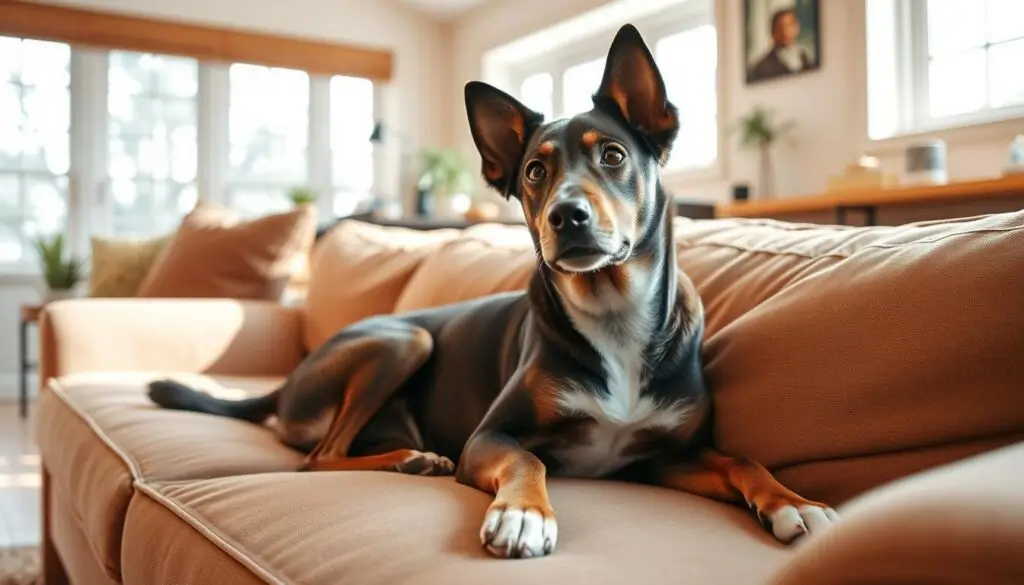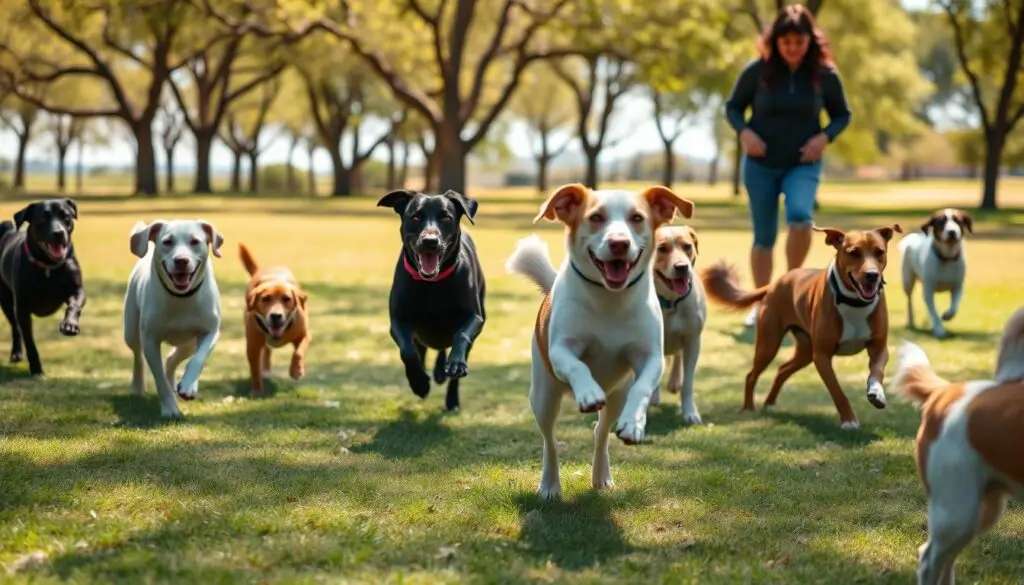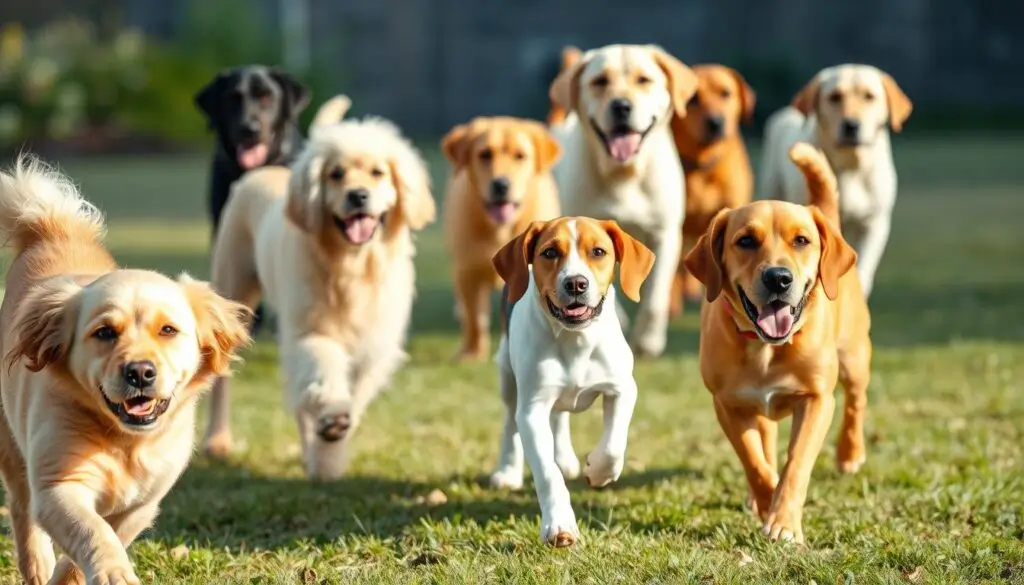Medium Dog Breeds: Your Ultimate Guide to Choosing the Best Fit
Choosing the perfect dog breed is a big decision. It shapes years of companionship. Medium-sized dogs are perfect for small spaces and active families. They fit well on your couch and match your lifestyle, bringing joy without being too much.
This guide explores breeds like English Bulldogs, Beagles, and Collies. Each has unique traits for your needs. Medium-sized dogs are 30 to 50 centimeters tall. They balance energy, care, and space needs well.
Whether you’re new to dog ownership or have experience, this article helps. It covers exercise, grooming, and temperament. Learn how breeds like the English Cocker Spaniel or Schnauzer do well in apartments or active homes. Every detail is here to make finding the right medium dog breed easier.
Table of Contents
Key Takeaways
- Medium dog breeds measure 30–50 cm tall, offering versatility for different living spaces.
- English Bulldogs sleep up to 18 hours daily, while Beagles need daily park playtime to stay happy.
- Medium-sized dogs cost less to feed than large breeds, saving on food expenses over time.
- Breeds like Schnauzers need regular grooming, while Keeshonds require minimal brushing.
- Popular breeds like the English Cocker Spaniel lead in long-haired medium dog preferences.
Understanding What Defines Medium Dog Breeds
Choosing the right medium-sized dog starts with knowing their size, traits, and how they differ. Here’s what makes medium dog breeds unique.
Weight and Size Classifications
Most medium-sized dogs fall into these ranges:
- Weight: 20–60 lbs (9–27 kg), with some breeds like Corgis at 20–30 lbs and Golden Retrievers up to 75 lbs (though they’re medium-large)
- Height: 14–27 inches at the shoulder. Basset Hounds reach 14”, while Australian Cattle Dogs top 22”
Common Characteristics
Medium breeds share traits like:
- Moderate energy: Need 40–80 minutes of daily activity (e.g., Border Collies thrive with active owners)
- Adaptability: Live in apartments or homes but require more space than small breeds
- Grooming needs vary: Shetland Sheepdogs need regular brushing, while Keeshonds require less maintenance
How Medium Dogs Compare to Small and Large Breeds
Compared to smaller breeds:
- Larger frames mean fewer joint issues but higher space needs
- Longer lifespans (10–17 years) than small breeds like Chihuahuas
Compared to large breeds:
- Lower food costs and health risks like bloat (common in Great Danes)
- Less hip dysplasia risk than Saint Bernards or Mastiffs
Popular medium-sized dog breeds like the Beagle and Bull Terrier balance size and lifestyle needs. Their versatility makes them a top choice for families and active owners alike.
Benefits of Choosing a Medium-Sized Dog
Medium dog breeds are perfect for many lifestyles. They weigh between 20–50 lbs, making them easy to handle. They are great for apartment living, needing regular walks and playtime.
They have the right amount of energy for families. This means they don’t need as much care as working breeds. Their size is just right for most homes.
Choosing a medium dog can save money. They eat less than big dogs and have lower vet bills. They live for 10–13 years, offering long-term companionship without the health risks of giant or small breeds.
| Category | Exercise Needs | Living Spaces | Cost Efficiency |
|---|---|---|---|
| Medium Breeds | 30–60 mins daily | Apartment to suburban | Lower than large breeds |
Top medium dog breeds like Border Collies and Beagles are versatile. They are smart and easy to train, perfect for new owners. They fit well in active or calm homes.
They have fewer behavioral problems than small breeds if socialized right. When picking a medium dog, think about their energy and grooming needs. But, most need less care than big dogs.
Top Medium Dog Breeds for Families
Choosing the right medium-sized dog breeds for families means finding a match for your lifestyle. Medium dog breeds like Golden Retrievers or Bulldogs are great for families. They are loyal and don’t need too much space or energy.
“A dog’s social nature and patience are key to harmonious family life,” says the American Kennel Club, emphasizing the need for breeds that balance energy and calmness.
Kid-Friendly Medium Breeds
- Golden Retrievers (55–75 lbs): playful yet patient with children’s antics.
- Labrador Retrievers (55–80 lbs: adaptable to kids’ schedules and energetic play.
- Bearded Collies (40–60 lbs: gentle with toddlers and tolerant of roughhousing.
Medium Dogs That Get Along With Other Pets
- Basset Hounds (40–65 lbs: calm around cats and other dogs.
- Bulldogs (40–50 lbs: friendly and non-confrontational with other animals.
- Poodles (60–70 lbs: social and eager to engage with other pets.
Medium Breeds Known for Reliability and Patience
- Australian Shepherds (50–65 lbs: steady and focused in chaotic environments.
- Vizslas (55–60 lbs: affectionate and eager to please busy households.
- Portuguese Water Dogs (35–60 lbs: reliable guardians with consistent behavior.
When looking at top medium dog breeds, think about their exercise and social needs. Collies or Whippets might be good for quieter homes. But, if you’re an active family, Labradors or Shepherds could be perfect. Choose breeds that fit your family’s lifestyle and space.
Best Medium Dog Breeds for Apartments and Urban Living
Living in the city doesn’t mean you can’t have a big dog. Medium dog breeds for apartments can do well in small spaces if they fit your lifestyle. There are 14 breeds that are perfect for city living, despite what many think.
Look for breeds that are small enough for your apartment, don’t need a lot of exercise, and are quiet. This makes them great for shared living spaces.
Space-Efficient Medium Breeds
Some medium-sized dogs are perfect for small homes. Basenjis (22-28 lbs) are low-energy and happy indoors. American Eskimo Dogs (25-35 lbs) also do well in tight spaces.
Whippets (25-40 lbs) can be trained to fit into small homes too. They need a bit of space but can adapt to 500-800 sq. ft. apartments with regular walks.
Medium Dogs With Lower Exercise Needs
Got a busy schedule? Choose breeds that love to relax. Basset Hounds (40-65 lbs) and Chinese Shar-Pei (35-64 lbs) only need 30-60 minutes of activity a day. They’re perfect for people who work a lot.
Stay away from high-energy dogs like Labradors. They need more room to run around.
Quieter Medium Breeds for Close Quarters
Want to keep the peace with your neighbors? Choose breeds like Basenjis (they bark very little) and Chinese Shar-Pei (they’re naturally quiet). Whippets are also calm indoors.
Avoid loud dogs like Beagles. They can disturb others. Training can help, but pick breeds that are naturally quiet.
Check with your landlord about breed restrictions. Many ban big dogs like mastiffs. Remember, regular walks and mental games are key. With the right breed, like a Basenji or Shar-Pei, you can have a great urban pet.
Popular Medium-Sized Dog Breeds and Their Temperaments
Choosing the right medium-sized dog means understanding their unique personalities. These medium dog breeds come in different temperaments to fit your lifestyle:
- Australian Shepherd: Smart and full of energy, they love to work and be loyal. Their herding skills are great for active owners.
- Basset Hound: They are calm but can be stubborn. Their curiosity is charming, but they need firm training to stop them from following scents.
- Golden Retriever: Friendly and outgoing, they love people and make great family pets.
- Husky: Mischievous and social, they need lots of activity every day to stay happy.
- Labrador Retriever: Happy and eager to please, they fit well into many homes.
- Boxer: Playful and protective, they bond strongly with their owners and need early socialization.
- Poodle: Bright and easy to adapt, they do well in obedience training and are good for those with allergies.
Think about a medium-sized dog’s energy level and if it fits your lifestyle. Australian Shepherds need lots of activity, while Basset Hounds prefer shorter walks. Huskies and Vizslas love to be with people, and Bulldogs need gentle exercise because of their body type. Make sure to research their needs to see if they match your lifestyle. Remember, even in popular medium-sized dog breeds, each dog is unique. Training and socialization play a big role in shaping their behavior.
Medium Dog Breeds for First-Time Owners

Choosing the right medium dog breeds as a new owner is key. Look for breeds that are easy to train and fit your lifestyle. These medium-sized dogs are great because they are friendly and easy to care for.
Easy-to-Train Medium Breeds
Labs, Goldens, and Poodles are known for being easy to train. Best medium dog breeds include:
- Labrador Retrievers: They love to learn and are the perfect size for most homes.
- Golden Retrievers: They are friendly and respond well to positive training.
- Poodles: Smart and quick to learn, but their fur needs regular grooming.
Low-Maintenance Medium Dogs
Boxers and Vizslas are low-maintenance but need active owners. For less work, consider these breeds:
- Bichon Frisés: Small and fluffy, they need regular grooming but are very affectionate.
- Papillons: Small but strong, they are great for apartment living.
Adaptable Breeds for Beginners
Greyhounds and Beagles are forgiving of training mistakes. They are calm and perfect for new owners. They are known for:
- Being patient with irregular schedules
- Requiring less exercise (20–30 minutes a day)
- Being good with first-time owners through rescue programs
“The key is matching your lifestyle to the breed’s nature—not forcing the dog to fit your habits,” advises canine behaviorists.
Remember, all medium dog breeds for first-time owners need daily interaction. Look into adoption programs that check the dog’s temperament before you adopt.
Health Considerations for Medium Dog Breeds
Choosing medium dog breeds means knowing about health risks. Many medium-sized dogs can get hip dysplasia or heart problems. Regular vet visits and care can help prevent these issues.
- Follow vaccination schedules: DHPP and rabies shots are critical for puppies and adults.
- Monitor weight to reduce strain on joints—especially for breeds like Labradors prone to obesity.
- Watch for breed-specific issues: Bulldogs may face breathing issues, while Dachshunds need spinal care.
| Breed | Common Health Risks |
|---|---|
| Labrador Retriever | Obesity, hip dysplasia |
| Australian Shepherd | Eye disorders, epilepsy |
| Golden Retriever | Cancer, heart disease |
| Bulldog | Respiratory issues, skin infections |
“Annual checkups are vital for early detection of hereditary conditions in best medium dog breeds,” advises Dr. Jane Collins, a veterinary specialist.
Senior dogs over 7 years need yearly blood tests and dental cleanings. For puppies, start vaccinations at 6-8 weeks and ensure spaying/neutering after 6 months. Always ask breeders for health clearances when adopting to avoid genetic issues.
Maintain a balanced diet and exercise routine. Conditions like diabetes in Miniature Schnauzers or eye problems in Poodles require proactive management. Prioritize breeds with lower inherited risks to ensure a healthier companion for years to come.
Exercise and Training Needs of Medium-Sized Dogs
Every medium dog breed has its own exercise and training needs. Whether you have an energetic Border Collie or a laid-back Bulldog, knowing these needs is key. This ensures your pet stays healthy and happy. Breeds like Labs and Huskies do well with routines tailored just for them.

Typical Exercise Requirements
Activity levels differ among medium dog breeds. Here’s a quick look:
- High-energy breeds: Border Collies and German Shorthaired Pointers need 90+ minutes daily of running, fetch, or agility courses.
- Moderate-energy breeds: Labs and Australian Shepherds require 60–90 minutes of walks, hikes, or playtime.
- Lower-energy breeds: Basset Hounds and Bulldogs may need only 30–60 minutes of gentle walking or indoor play.
Note: Puppies and seniors need adjusted routines. Consult a vet for dogs with joint issues or brachycephalic breeds like Pugs, who overheat easily.
Training Approaches That Work Best
“Consistency and positivity build trust,” says the American Kennel Club. Use treats and praise to reward good behavior.
Breeds like Collies learn quickly, while Bassets may resist commands. For stubborn dogs, short, frequent sessions work better than long drills. Avoid force-based methods—they can backfire with independent breeds like terriers.
Mental Stimulation Needs
Mental fatigue prevents boredom. Try these strategies:
- Puzzle toys to challenge Border Collies and Huskies.
- Hide-and-seek games for scent-driven breeds like Beagles.
- Training games like “sit-stay” for Bulldogs to keep minds engaged.
Incorporate mental tasks into daily routines to keep your medium-sized dog calm and well-adjusted.
Cost of Owning Medium Dog Breeds
Getting a dog means planning your budget carefully. Medium dog breeds have their own costs. You’ll need to pay for adoption fees, vet visits, and supplies, which can add up to about $2,100. Adopting from a shelter can save you money, making it a smart choice for finding the best medium dog breeds.
Every year, you’ll spend around $2,500 on your dog. This includes food, vet bills, and grooming. Here’s a detailed look:
- Food: $446/year for quality diets
- Vet Care: $423/year for checkups and vaccines
- Grooming: $190/year for baths and haircuts
- Emergency costs: Up to $631 for unexpected medical needs
| Cost Category | Medium Dogs | Small Dogs | Large Dogs |
|---|---|---|---|
| Annual Food Cost | $446 | $313 | $669 |
| Spay/Neuter | $160 | $120 | $200 |
| Emergency Care | $631 | $450 | $800 |
Think about the long-term costs for your dog’s 10–15 years. Insurance and emergency funds are key. The ASPCA says medium dogs cost between small and large breeds, with an average of $2,489 a year. This compares to small dogs ($1,831) and large dogs ($2,569), showing where medium dogs fit in your budget.
Conclusion: Finding Your Perfect Medium Dog Breed Match
Choosing the right medium dog breed is all about matching their needs to your lifestyle. These dogs come in all sorts of personalities, from the energetic Australian Shepherd to the laid-back Bulldog. First, think about where you live. If you’re in an apartment, breeds like Beagles or Basset Hounds are great because they need only moderate exercise.
On the other hand, if you’re always on the move, dogs like Vizslas or Cocker Spaniels are perfect. They love to run and play every day. Also, consider how much time you have. Bulldogs might need less exercise but they require regular grooming. Meanwhile, high-energy breeds like Australian Cattle Dogs need lots of training.
Health and temperament are also key. Look into breeds like Labradors or Poodles, which tend to live longer. Don’t forget to visit shelters or rescues to meet dogs in person. Each dog has its own unique personality.
Mixed-breed dogs can be a great choice too, as they might have fewer health issues. And don’t overlook senior dogs in shelters. They often make wonderful companions for those who want a calm pet.
Adopting a medium dog is a big commitment. Look at the best medium dog breeds based on your lifestyle and living situation. Whether you want a low-maintenance pet, a high-energy friend, or a family dog, there’s a perfect match out there. Take your time to find the right one, and you’ll have a rewarding partnership.

